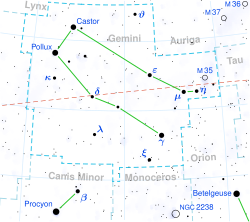Location of 74 Geminorum in Gemini (circled) [1] | |
| Observation data Epoch J2000 Equinox J2000 | |
|---|---|
| Constellation | Gemini |
| Right ascension | 07h 39m 28.593s [2] |
| Declination | +17° 40′ 28.28″ [2] |
| Apparent magnitude (V) | 5.05 [3] |
| Characteristics | |
| Spectral type | K5.5III [3] |
| Apparent magnitude (U) | 8.53 [3] |
| Apparent magnitude (B) | 6.61 [3] |
| Apparent magnitude (G) | 4.348±0.003 [3] |
| Apparent magnitude (J) | 2.11 [3] |
| Apparent magnitude (H) | 1.32 [3] |
| Apparent magnitude (K) | 1.14 [3] |
| B−V color index | 1.616±0.007 [4] |
| Astrometry | |
| Radial velocity (Rv) | 25.38±0.19 [5] km/s |
| Proper motion (μ) | RA: +5.374 mas/yr [2] Dec.: −1.199 mas/yr [2] |
| Parallax (π) | 5.1083±0.0964 mas [2] |
| Distance | 640 ± 10 ly (196 ± 4 pc) |
| Absolute magnitude (MV) | −1.01 [1] |
| Details | |
| Mass | 1.2 [6] M☉ |
| Radius | 106 [2] R☉ |
| Luminosity | 2,371 [2] L☉ |
| Surface gravity (log g) | 1.06 [7] cgs |
| Temperature | 3,919 [7] K |
| Age | 1.9 [7] Gyr |
| Other designations | |
| f Gem, 74 Gem, BD+18 1701, Gaia DR2 671137503843195392, Gaia DR3 671137503843195392, HD 61338, HIP 37300, HR 2938, SAO 97120, PPM 124288, WDS J07395+1740AB, TIC 16134382, TYC 1365-2474-1, GSC 01365-02474, IRAS 07366+1747, 2MASS J07392860+1740282 | |
| Database references | |
| SIMBAD | data |
74 Geminorum (f Geminorum) is a K-type giant star in the constellation Gemini. It is located about 640 light-years from Earth based on its Gaia DR3 parallax. The star is often subject to lunar occultations, allowing an accurate measurement of its angular diameter. [8] It has an apparent magnitude of 5.05, making it faintly visible to the naked eye. [1]
